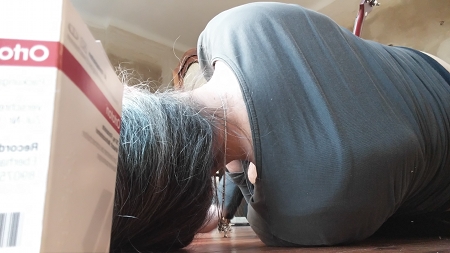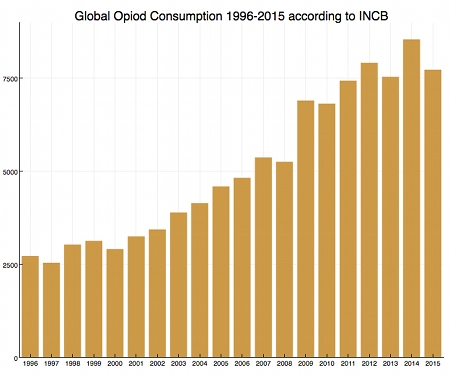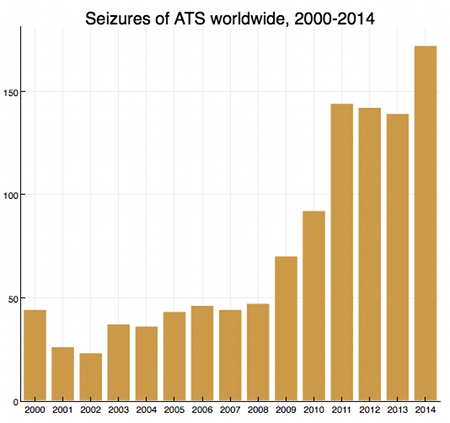Some Opiods and ATS stats

“End-Hauptbereichsverspannungsmedikamente für Nacknmuskuleere Speerre” collaborative artwork by artists group “Entente Sublimale”
More or less recently I had seen a video in which a famous politician was talking in a way which gave me the impression that this person was on drugs. I may have been wrong, but still. It should be said that in the video the person had to comment on a very tragic event and that was sofar the only time where I saw this politician in this state.
Then there was also Jeroen Dijsselbloems recent controversial remarks about economic failures due to alcohol and women and the following discussions, where it was e.g. remarked that after taking interest payments away, the economics of the Netherlands seems to look actually worse than that of Southern Europe. All this made me look a bit at examples of drugs and in particular opiods in connection with economics and politics.
In the Washington Post article “Americans use far more opioids than anyone else in the world” of march 2015 by professor Keith Humphreys a graphical overview over some countries’ opiod uses is given. The data is from the INCB report 2016 (interestingly the Washington Post now keeps its own copy). As far as I understood the INCB (International Narcotics Control Board) covers the legal narcotic drugs. Illicit drugs are referenced in the UNDOC reports.
Anyways as you can see in this graphics (or in the table in the report on page 226) Germany ranks third in opiod use, which is -if you know a bit from Germany’s history – not without brisance. I will come back to this later.
It is useful to recap a bit about the different types of drugs.
According to this graphics (or the INCB report) the top opiod pain killers used in the US were Hydrocodone, Oxycodone and Fentanyl. All have a high danger of addiction.
In the US those pain killers, handed out in prescriptions led to something which is now called an epidemic – according to business insider:
In 1991, the National Institute on Drug Abuse reported that doctors wrote 76 million prescriptions. By 2011, that number had hit 219 million.
The explosion in prescriptions has subsequently led to an explosion in overdoses and abuse, leading the federal government to dub opioid abuse an epidemic.
The New York times had made a visualization of deaths from overdoses where it can be seen how especially rural areas are affected by the epidemic. How this affects concrete families is described in the article:
“2 of a Farmer’s 3 Children Overdosed. What of the Third — and the Land?”
And apparently too fastly cutting down on pain killers apparently made things worse and let amongst others to heroin addiction.
I haven’t heard yet that opiod use was called an epidemic in Germany, although according to the report and the table XIV.1.a. on page 226 Germany uses 30796 vs. 47580 (US) daily doses per million inhabitants per day. That is about two third of the US consumption. The biggest amounts are here though not Hydrocodone like in the US but Fentanyl – the drug which apparently killed the musician Prince.
Here a diagram made from numbers in the report (p. 249-250) about the rise of global use of opiods. Have a look at the jump in 2008:
It should also be said that opiods are not the only addictive “medical” drugs but for example in the US Metamphetamine is apparently prescribed for treating obesity and ADHD. Since it is not narcotic it is not mentioned in the INCB report.
Methamphetamine, also known as Crystal Meth, had played also a role in World War II under the name Pervitin. Amongst others it was called “Panzerschokolade” (“tank chocolate”) or Stuka-Tablette (“dive bomber pill”). Methamphetamine is a substituted amphetamine, so it belongs to the family of amphetamines for which corresponding pharmaceutical products are e.g. called Adderall, Dyanavel XR, and Evekeo and which are apparently not too uncommon among students.
I tried to gather some statistics concerning amphetamine type drugs. The following bar chart is assembled from the World Drug Report 2010 and 2016 (Fig 192 p.208 in WDR 2010, 2000-2008 and Fig. 65 p. 53, 2009-2014) which displays the seizures of Amphitamine-Type Stimulants (ATS) worldwide in tons. The diagram has to be taken with a grain of salt, because for 2009-2014 there were no explicit values listed and so I just read the values of the diagram. (Unfortunately the data itself is spread over different world regions in the UNDC tables coming with different units, so it would have been too much work to calculate the numbers from the tables directly. There is a somewhat similar overview in the WDR 2016 page xii intro).
Not known or forgotten by many – already in World War II Methamphetamine was leading to a kind of drug epidemic among the german soldiers. Moreover Nazi leaders were addicted including Hitler himself who used the above mentioned drug Oxycodone and cocaine. The brand name for the Oxycodone pills were at this time Eukodal. According to the book “Blitzed” by Norman Ohler:
When Hitler fell seriously ill in 1941, however, the vitamin injections that Morell had counted on no longer had any effect – and so he began to ramp things up. First, there were injections of animal hormones for this most notorious of vegetarians, and then a whole series of ever stronger medications until, at last, he began giving him a “wonder drug” called Eukodal, a designer opiate and close cousin of heroin whose chief characteristic was its potential to induce a euphoric state in the patient (today it is known as oxycodone). It wasn’t long before Hitler was receiving injections of Eukodal several times a day. Eventually he would combine it with twice daily doses of the high grade cocaine he had originally been prescribed for a problem with his ears, following an explosion in the Wolf’s Lair, his bunker on the eastern front.
->related randform post Virtual asset sizes


April 13th, 2017 at 9:00 am
I recommend you to listen to e.g. this World War II History Lesson (Crash course # 38) at around minute 8:15, citation from the video:
April 17th, 2017 at 8:46 pm
I mentioned the drug problems around WWII within Germany and in particular Hitlers drug problems as a component which I think played a role in WWII but I certainly wouldn’t claim that those drug problems could “explain the Nazi’s decision to invade Russia.”
Moreover although I wouldn’t call food the “most interesting” reason for the invasion, it is right that food and the economy in general played a role in the rise of Hitler and they played a role in WWII war decisions. I think though it is debatable to what extend the average “farm size” played a major role in those Reich economics problems.
Anyways even if Hitlers mental state certainly played a role it is unclear how important this component was. Finally Hitler wasn’t acting alone, in fact he was elected and even his quasi-plenary powers which he gained by the Enabling Act were approved by a rather big share of the members of the parliament. That is if the centre party would have voted against the Enabling Act then he would have missed the two third majority and his rise to power would have been at least more difficult.
From Wikipedia:
April 20th, 2017 at 2:49 pm
ooo what gloomy discussion here!
Think you better let bygones be bygones and discuss more merriful things. Like magic, golden carriages, fairies….:
https://www.youtube.com/watch?v=WRuHM6rLSF8
love and peace to all
💟☮️
May 3rd, 2017 at 8:17 am
It is hard to comprehend that the Nazi’s deemed the jews as “unfit” – such a loss of reality is even for megalomanic all brawns remarkable, finally there were distinguished professors and even Nobel laureats fleeing the country which led to an enormous brain drain in Germany.
May 3rd, 2017 at 9:47 am
I just say: Albert Einstein, John von Neumann, Robert Oppenheimer etc.
May 7th, 2017 at 10:10 am
Richard said:
@Richard
This particular Nazi attitude may be very deeply rooted in german culture. There is an interesting article at foreign policy about Germany’s “Besserwisserei” . Some excerpts:
and
You probably know about “aranyan physics” or “Deutsche Physik”.
May 31st, 2017 at 1:26 pm
Please take into account that especially for officers it was hard to do something against the “brown pest”, i.e. the Nazi’s, because they had sworn an oath. Unfortunately I have only found this artcle here in german about a documentary which deals with the officers resistance, it documents amongst others the Oster Conspiracy and Operation Valkyrie. I don’t know if the film exists in english:
From the article:
Translation:
January 22nd, 2018 at 2:29 pm
It is not only drugs that are a problem in western world but also nutrition.
I am not sure whether everything should be automatized in the way as shown as here:
https://www.youtube.com/watch?v=jCTv-4sFt_s
but it seems that a more stringently structured, intelligent food experience is necessary.
March 10th, 2019 at 6:50 pm
I would like to mention that in the US there are practical counter actions which adress the opiod crisis in a truly smart way – like this wristband detects overdoses: https://blog.adafruit.com/2019/01/09/this-wristband-detects-an-opiate-overdose-wearablewednesday/
November 8th, 2019 at 10:09 pm
Morell ?! – Hitler had a french doctor who fed him drugs ?! – wow!
November 12th, 2019 at 8:19 am
I don’t understand why you meant that Morell was a french doctor.
Theodor Morell was born in Trais-Münzenberg in Upper Hesse.and raised in Germany. According to the website Deutsche Biographie his parents were Karl Morell (1857-n. 1933), primary school teacher in Trais-Münzenberg and Elise Häuser (1857–1933) who came from a farmer’s family. There is only a slight french family connection – that is the Morell’s were Huguenotes which came to Friedrichsdorf in 1687 with other Huguenottes. Actually very close-by Morells with a higher social status than that of a primary school teacher also emigrated, like the father of tabacco manufacturer George Christophe Morell. If this sounds like a lot of Morells in that region one has to note that Morell is a not too untypical french name. It is even connected to nobility.
So the family had been living for roughly 200 years in Germany before Theodor was born.
The only other apparent “french connection” was that Theodor Morell studied a couple of semesters in Grenoble and Paris, but that doesn’t make him a french doctor.
November 16th, 2019 at 8:23 am
@morphiumism
If Morell would have been a french spy then he would have killed Hitler right at the beginning of the war, at least during the battle of France:
November 21st, 2019 at 7:44 pm
@nad @Historian
What do you think about the death of Reinhard Heydrich after the Operation Anthropoid?
In the Biography of Reinhard Heydrich by Robert Gerwarth it is written that:
Heydrich first seemed to recover, but then seven days after the attack he more or less suddenly collapsed and died.
November 24th, 2019 at 1:21 pm
@morphiumism
I don’t know what this question is supposed to insinuate. Do you want to suggest that Morell killed Heydrich? This doesn’t make sense already for the fact that Hitler was certainly more important than Heydrich. Heydrich was subordinate to Hitler. Why kill the subordinate and let the decision maker alive?
September 14th, 2020 at 9:47 am
Thanks for the drug- and also the game industry statistics, Can you provide us with more recent numbers?
You wrote:
It should be added that towards the end of the war german soldiers were given even stronger drugs, like the D-IX pills which were a mixture of 5 mg Oxycodone (Eukodal), 5 mg Kokain und 3 mg Methamphetamin (Pervitin), a mixture that was invented by Nazidoctor Gerhard Orzechovski.
The book “Blitzed” has now a video documentary and starting at minute 38.05 you can hear Norman Ohler talk about Orzechovski’s “medication”.
November 12th, 2020 at 9:48 am
I miss somehow a discussion about self-control. I think it is problematic to invariably stage drug abusers as dismal victims. Former Purdue boss R. Sackler wrote:
I understand that in view of the opiod crisis one may find this opinion disturbing, but I think one should at least discuss drug abuse in conjunction with self-control. It should also be said that Sackler is now actively participating in a mitigation of the crisis by a new patent for a treatment for opioid use disorder according to businessinsider.
September 16th, 2021 at 8:17 am
Could you please provide some info about gang crime numbers? Given the recent incidents for example in Kista and Norsborg this seems to be on the rise.